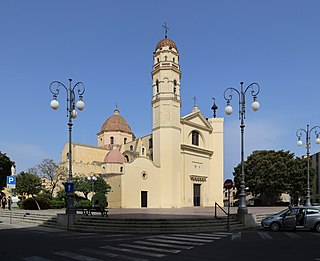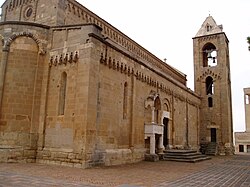Castro is a Romance language word that originally derived from Latin castrum, a pre-Roman military camp or fortification. The English-language equivalent is chester.

Sant'Antioco is the name of both an island and a municipality (comune) in southwestern Sardinia, in the Province of South Sardinia, in Sulcis zone. With a population of 11,730, the municipality of Sant'Antioco it is the island's largest community. It is also the site of ancient Sulci, considered the second city of Sardinia in antiquity.

Quartu Sant'Elena, located four miles East from Cagliari on the ancient Roman road, is a city and comune in the Metropolitan City of Cagliari, Sardinia, Italy. It is the third biggest city of Sardinia with a population of 71,216 as of 2015.

Tharros was an ancient city and former bishopric on the west coast of Sardinia, Italy.
Montefino is a small town and predominantly rural comune of the province of Teramo in the Abruzzo region of eastern Italy. During the second half of the twentieth century the population of the comune declined steadily from 2,399 in 1951 to 1,184—less than half—in 2001.

Ottana is a comune (municipality), former bishopric and Latin titular see in the Province of Nuoro in the Italian region Sardinia, located about 110 kilometres (68 mi) north of Cagliari and about 25 kilometres (16 mi) southwest of Nuoro.

Domusnovas, Domusnoas or Domus Noas in Sardinian language, is a comune (municipality) in the Province of South Sardinia in the Italian region Sardinia, located about 40 kilometres (25 mi) northwest of Cagliari and about 20 kilometres (12 mi) northeast of Carbonia, in the Sulcis-Iglesiente region, in the valley of the Cixerri river.

San Gavino Monreale is a comune (municipality) in the Province of South Sardinia in the Italian region Sardinia, located about 45 kilometres (28 mi) northwest of Cagliari, and roughly halfway between the latter and the town of Oristano.

Oschiri is a comune (municipality) and former bishopric in the Province of Sassari in the Italian region Sardinia, located about 170 kilometres (110 mi) north of Cagliari and about 40 kilometres (25 mi) southwest of Olbia.

The Archdiocese of Cagliari is a Latin archdiocese of the Catholic Church centred on the city of Cagliari. It holds the Primacy of Sardinia.
Juan Pilars was a Roman Catholic prelate who served as Archbishop of Cagliari (1514–1521) and Bishop of Sulcis (1503–1514).

The Diocese of Alghero-Bosa is a Latin Church diocese of the Catholic Church. It is a suffragan of the Metropolitan Archdiocese of Sassari, on Sardinia, insular Italy.
Benedict of Cagliari was a Benedictine Bishop of Dolia, Sardinia. He was a monk at the abbey of St. Saturninus in that city when he was made bishop in 1107. Serving for five years, Benedict then retired to the basilica abbey.

Dolianova Cathedral, dedicated to Saint Pantaleon, is a Roman Catholic cathedral church in the historical center of Dolianova, Sardinia, Italy. It is one of the main Romanesque buildings in the island. Formerly the episcopal seat of the diocese of Dolia, it is now a co-cathedral in the Archdiocese of Cagliari.
The Diocese of Castro di Sardegna was a Roman Catholic diocese located in the town of Oschiri in the Province of Sassari in the Italian region of Sardinia. In 1503, it was suppressed along with the Diocese of Bisarcio and the Diocese of Ottana to form the Diocese of Alghero.
The Diocese of Sulcis or Diocese of Sulci was a Roman Catholic diocese located in the Sulcis region in the Province of South Sardinia. Erected in 484, it was suppressed in 1514. In 1966, it was restored as a Titular Episcopal See.
The Diocese of Sorres or Diocese of Sorra was a Roman Catholic diocese located in the village of Borutta in the province of Sassari, northern Sardinia, Italy. Erected in the 11th century, it was suppressed in 1503 to the Archdiocese of Sassari. Its cathedral was San Pietro di Sorres.
The following is a timeline of the history of the city of Cagliari, Sardinia, Italy.

The Sardinian Romanesque is the Romanesque architectural style that developed in Sardinia. The Romanesque architecture in Sardinia has had a remarkable development since the early origins, during the Giudicati era, and for a long period. His expressions, although autonomous, are not classifiable in a recognizable image, since in the island the Romanesque manifested itself with unusual results but in numerous forms; this is due to the establishment in Sardinia of several religious orders, coming from various Italian regions and from France. Consequently, in the architectures of that era Pisan, Lombard and Provençal influences are recognizable as well as traces of the passage of workers, coming from the Iberian Peninsula, of Islamic culture.















